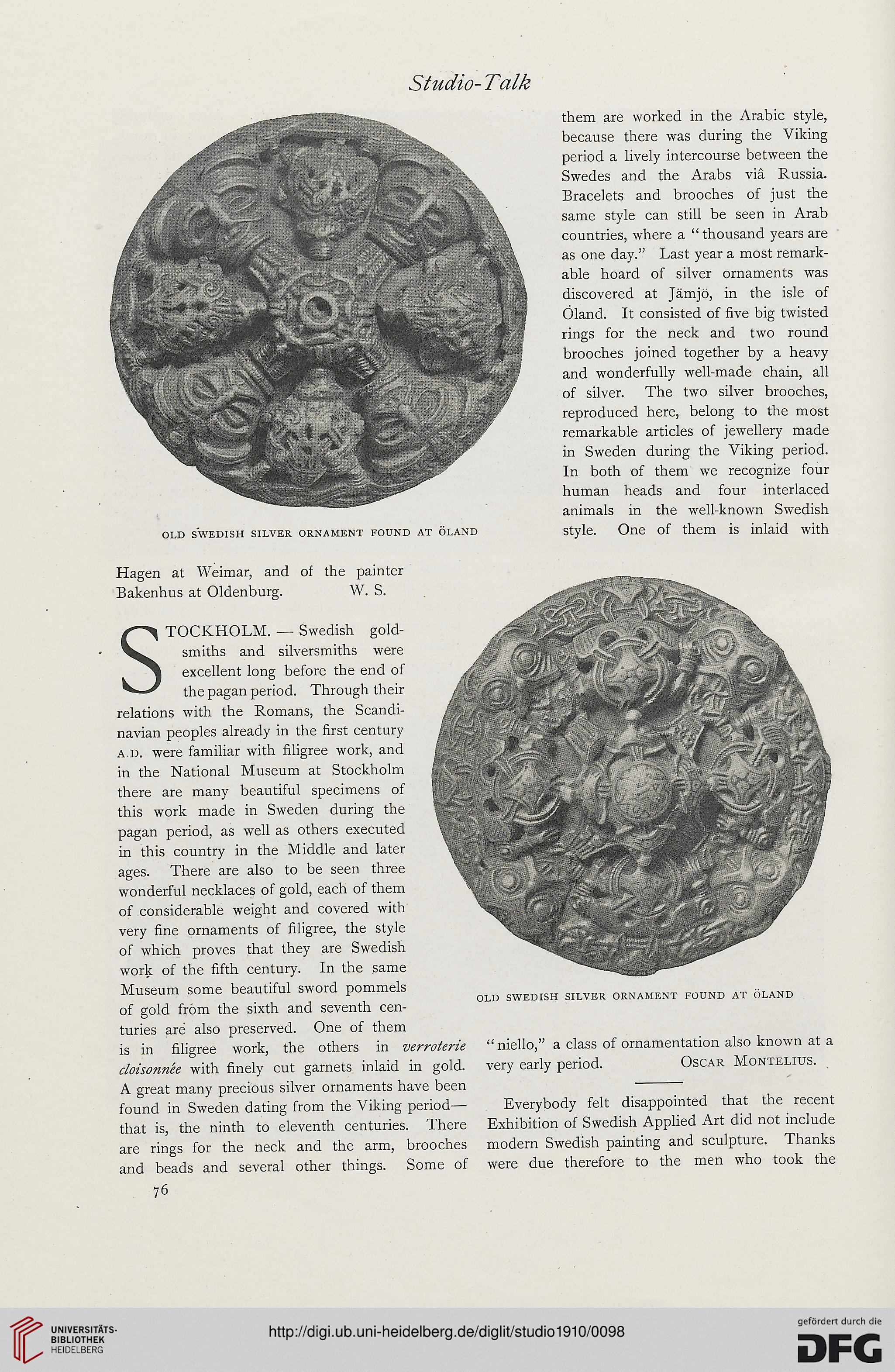Studio- Talk
them are worked in the Arabic style,
because there was during the Viking
period a lively intercourse between the
Swedes and the Arabs via. Russia.
Bracelets and brooches of just the
same style can still be seen in Arab
countries, where a " thousand years are
as one day." Last year a most remark-
able hoard of silver ornaments was
discovered at Jamjd, in the isle of
Oland. It consisted of five big twisted
rings for the neck and two round
brooches joined together by a heavy
and wonderfully well-made chain, all
of silver. The two silver brooches,
reproduced here, belong to the most
remarkable articles of jewellery made
in Sweden during the Viking period.
In both of them we recognize four
human heads and four interlaced
animals in the well-known Swedish
old Swedish silver orkament found at oland style. One of them is inlaid with
Hagen at Weimar, and of the painter
Bakenhus at Oldenburg. W. S.
STOCKHOLM. — Swedish gold-
smiths and silversmiths were
excellent long before the end of
the pagan period. Through their
relations with the Romans, the Scandi-
navian peoples already in the first century
a d. were familiar with filigree work, and
in the National Museum at Stockholm
there are many beautiful specimens of
this work made in Sweden during the
pagan period, as well as others executed
in this country in the Middle and later
ages. There are also to be seen three
wonderful necklaces of gold, each of them
of considerable weight and covered with
very fine ornaments of filigree, the style
of which proves that they are Swedish
work of the fifth century. In the same
Museum some beautiful sword pommels
r , . r . , . . , , old swedish silver ornament found at oland
of gold from the sixth and seventh cen-
turies are also preserved. One of them
is in filigree work, the others in verroterie "niello," a class of ornamentation also known at a
cloisonnee with finely cut garnets inlaid in gold, very early period. Oscar Montelius.
A great many precious silver ornaments have been -
found in Sweden dating from the Viking period— Everybody felt disappointed that the recent
that is, the ninth to eleventh centuries. There Exhibition of Swedish Applied Art did not include
are rings for the neck and the arm, brooches modem Swedish painting and sculpture. Thanks
and beads and several other things. Some of were due therefore to the men who took the
76
them are worked in the Arabic style,
because there was during the Viking
period a lively intercourse between the
Swedes and the Arabs via. Russia.
Bracelets and brooches of just the
same style can still be seen in Arab
countries, where a " thousand years are
as one day." Last year a most remark-
able hoard of silver ornaments was
discovered at Jamjd, in the isle of
Oland. It consisted of five big twisted
rings for the neck and two round
brooches joined together by a heavy
and wonderfully well-made chain, all
of silver. The two silver brooches,
reproduced here, belong to the most
remarkable articles of jewellery made
in Sweden during the Viking period.
In both of them we recognize four
human heads and four interlaced
animals in the well-known Swedish
old Swedish silver orkament found at oland style. One of them is inlaid with
Hagen at Weimar, and of the painter
Bakenhus at Oldenburg. W. S.
STOCKHOLM. — Swedish gold-
smiths and silversmiths were
excellent long before the end of
the pagan period. Through their
relations with the Romans, the Scandi-
navian peoples already in the first century
a d. were familiar with filigree work, and
in the National Museum at Stockholm
there are many beautiful specimens of
this work made in Sweden during the
pagan period, as well as others executed
in this country in the Middle and later
ages. There are also to be seen three
wonderful necklaces of gold, each of them
of considerable weight and covered with
very fine ornaments of filigree, the style
of which proves that they are Swedish
work of the fifth century. In the same
Museum some beautiful sword pommels
r , . r . , . . , , old swedish silver ornament found at oland
of gold from the sixth and seventh cen-
turies are also preserved. One of them
is in filigree work, the others in verroterie "niello," a class of ornamentation also known at a
cloisonnee with finely cut garnets inlaid in gold, very early period. Oscar Montelius.
A great many precious silver ornaments have been -
found in Sweden dating from the Viking period— Everybody felt disappointed that the recent
that is, the ninth to eleventh centuries. There Exhibition of Swedish Applied Art did not include
are rings for the neck and the arm, brooches modem Swedish painting and sculpture. Thanks
and beads and several other things. Some of were due therefore to the men who took the
76




